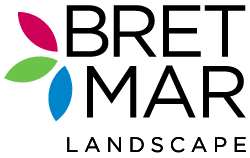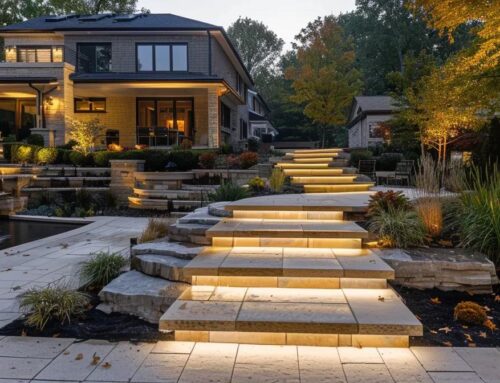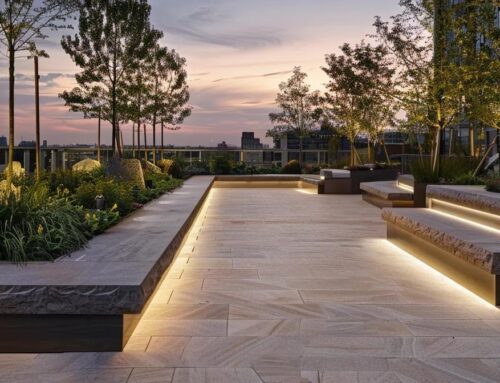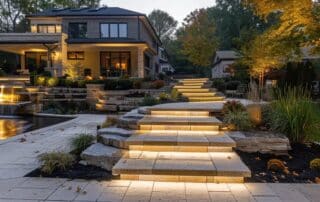Urban outdoor spaces often lack the character and functionality needed for modern living. This blog post will explore innovative urban hardscape designs, focusing on creative landscaping ideas, effective planning techniques, and materials that can elevate your outdoor area. If you are searching for “landscape near me” or looking for expert landscaping services, you will find practical solutions. By the end, you’ll gain insights on how to transform your patio into a stylish, durable space that complements your lifestyle and withstands the elements, utilizing quality building materials from Bret-Mar Landscape.
Understanding Urban Hardscape Designs for Modern Outdoor Spaces

Hardscape elements play a vital role in urban landscaping, transforming yards into functional outdoor spaces through our landscaping services provided by bret-mar landscape. I’ll discuss defining these elements, their significance in enhancing lawns and gardens, and how they can support green initiatives like pollinator habitats and herb gardens. Understanding these key features will highlight their importance in modern designs and address concerns like flood management.
Defining Hardscape Elements in Urban Settings
In urban settings, hardscape elements encompass various features that not only define the aesthetics of outdoor spaces but also enhance their functionality. Common materials like tile and concrete create pathways and sidewalks, forming essential connections between different areas in a bret-mar landscape. These surfaces can significantly impact the microclimate, influencing the local environment by providing habitats for various insect species while improving water drainage to address flood management challenges. For comprehensive landscaping services, consider exploring options like hardscape landscape near me:
- Defining hardscape with practical examples.
- Role of materials like tile and concrete in urban landscapes.
- Impact on microclimates and local biodiversity.
Importance of Hardscape in Landscaping Design
In my experience, hardscape elements are essential for effective urban design as they provide structure and functionality to outdoor spaces. By incorporating minimalist designs with materials such as stone and concrete, I can create vibrant areas that promote biodiversity, such as herb gardens featuring thyme and other pollinator-friendly plants. These designs not only enhance the visual appeal but also address practical needs, making urban environments more livable and sustainable.
Key Features of Contemporary Hardscapes
Contemporary hardscapes emphasize a blend of functionality and aesthetics, which I find crucial for creating inviting outdoor environments. Landscape professionals often highlight the use of durable materials, like stone and concrete walls, that not only provide structure but also define spaces in the front yard. Incorporating elements like mulch and textile ground covers enhances soil health and moisture retention while adding visual texture, making outdoor areas both practical and appealing.
Urban spaces thrive on change. Embracing innovative materials can transform any project into something remarkable.
Innovative Materials for Urban Hardscape Projects

I prioritize sustainable paving options in my hardscape projects, ensuring they align with contemporary landscaping needs. The use of permeable surfaces plays a significant role in water management, allowing for effective climate adaptation. Additionally, I incorporate recycled materials into my designs, showcasing how innovative approaches can enhance urban outdoor spaces. These topics will provide practical insights for architects and homeowners looking to optimize their landscapes.
Sustainable Paving Options
Sustainable paving options are essential for creating modern outdoor spaces that respect the environment and meet contemporary needs. Using materials like reclaimed brick offers a rustic charm while adapting seamlessly to different architectural styles, including bungalows. In the Pacific Northwest, I find that using permeable pavers allows for efficient water management and integrates well with vine plantings, effectively camouflaging hard surfaces within lush gardens.
- Importance of sustainable paving materials
- Examples of reclaimed brick and permeable pavers
- Benefits for water management and integration with plant life
Use of Permeable Surfaces for Water Management
The use of permeable surfaces in landscape design is vital for effective water management in urban environments. These materials allow water to infiltrate rather than run off, reducing flooding and promoting healthier soil, which I find creates a more balanced ecosystem. For instance, incorporating wood and stone sculptures next to permeable pathways can transform a typical yard into an inviting outdoor living room while demonstrating a commitment to sustainability, ultimately enhancing both aesthetic appeal and functionality.
Incorporating Recycled Materials in Design
In my hardscape projects, I often incorporate recycled materials to enhance both functionality and sustainability. For instance, creating a walkway from reclaimed bricks not only adds character to the space but also supports eco-friendly garden design. Additionally, using repurposed items such as wooden pallets for container gardens offers an innovative solution for urban environments, providing unique flooring options while promoting a greener lifestyle.
- Using reclaimed bricks for walkways to enhance garden design.
- Creating container gardens with repurposed materials.
- Promoting sustainability through innovative flooring solutions.
The right materials lay the groundwork for something great. Now, let’s see how these choices can spark fresh ideas in urban hardscape landscaping.
Creative Urban Hardscape Landscaping Ideas

Multi-functional outdoor spaces are essential in modern landscape design, as they maximize usability while enhancing aesthetic appeal. I’ll discuss how integrating greenery into hardscape designs can soften concrete surfaces, improve infrastructure, and create inviting environments. Additionally, I will highlight the importance of utilizing lighting to enhance these areas, ensuring they remain functional and beautiful even in snowy conditions.
Multi-Functional Outdoor Spaces
Creating multi-functional outdoor spaces is essential for maximizing usability while maintaining aesthetic appeal. In my projects, I often design porches with integrated seating that promote outdoor gatherings, paired with fences to provide privacy and enhance the overall sense of enclosure. Incorporating perennial plants around a cozy fireplace not only adds greenery but also defines zoning, allowing for distinct areas for relaxation and entertainment.
Integrating Greenery Into Hardscape Designs
Integrating greenery into hardscape designs is essential for creating a harmonious ecosystem in urban spaces. I often recommend using pavers alongside vibrant plants like maple trees to soften hard surfaces, especially in courtyards, where visual appeal and functionality are crucial. Incorporating features such as green roofs not only adds beauty but also promotes better air quality and supports local biodiversity, making these spaces more inviting and sustainable:
- Utilizing pavers with plant beds for aesthetic and functional benefits.
- Adding maple trees or similar greenery around courtyards.
- Implementing green roofs to enhance air quality and biodiversity.
Utilizing Lighting for Aesthetic Appeal
In my designs, utilizing lighting is crucial for enhancing the aesthetic appeal of outdoor spaces, especially in areas facing drought conditions where plants may thrive less. Integrating strategic lighting around features like a chair on a landscaped berm creates a cozy sanctuary for relaxation, allowing homeowners to enjoy their outdoor spaces even at night. Incorporating lights that mimic interior design elements helps create a seamless transition between indoor and outdoor living environments, enriching the experience for everyone involved:
- Prioritize lighting around seating areas for functional use.
- Enhance architectural features with focused illumination.
- Utilize low-voltage lighting to reduce environmental impact.
Now, let’s look at real examples of thriving urban hardscape designs. These case studies reveal how vision can transform ordinary spaces into lasting beauty.
Case Studies of Successful Urban Hardscape Designs

In examining transformative projects in urban areas, I highlight the invaluable lessons learned from renowned landscape architects. These insights reveal how thoughtful designs can foster community engagement through the strategic use of garden furniture, evergreen plants, and shade structures, while addressing critical issues like erosion. This section will explore tangible examples and actionable strategies, showcasing the significant impact of effective hardscape designs.
Transformative Projects in Urban Areas
In my experience, transformative projects in urban areas often feature elements like fountains and trellises, which create focal points and enhance the overall aesthetic. For instance, I recently participated in a project that included a fountain surrounded by allium plants, providing both visual interest and a habitat for local wildlife. Additionally, incorporating prairie-style landscaping with native plants not only improves biodiversity but also ensures low-maintenance construction, making urban spaces more inviting and sustainable for homeowners and communities alike.
Lessons From Renowned Landscape Architects
In observing the work of renowned landscape architects, I’ve learned valuable lessons about the integration of functional elements like retaining walls and stairs in urban hardscape designs. For instance, utilizing gravel in drainage solutions can significantly improve water management while enhancing the aesthetic appeal of outdoor spaces. Moreover, these architects emphasize the importance of creating adaptable landscapes that address common home improvement challenges, ensuring the designs are both practical and visually appealing for homeowners.
Impact of Design on Community Engagement
The impact of design on community engagement becomes clear through projects that incorporate elements like outdoor dining areas and functional decks. For instance, a recent renovation I worked on featured artificial turf surrounding a central gathering space, inviting families to spend time together and fostering neighborhood interactions. This thoughtful integration of greenery and man-made structures not only beautified the area but also encouraged residents to plant seeds of connection, reinforcing the sense of community in urban environments.
With successful designs laid out, I turn to the art of planning. Understanding these techniques will sharpen your vision for beautiful urban spaces.
Techniques for Planning Urban Hardscapes

When planning urban hardscapes, I focus on assessing space and functionality to ensure that designs meet practical needs. A balance of aesthetics and durability is vital, especially in urban areas where resilience against wind and weather is crucial. Engaging the community in design decisions further enriches the process, allowing landscape designers to incorporate elements like espalier trees that enhance sustainability and local character.
Assessing Space and Functionality
When assessing space and functionality for urban hardscapes, I focus on creating habitats that support local wildlife and enhance biodiversity. By incorporating native species such as ferns and other resilient plants, I foster environments that address stormwater management and promote healthier ecosystems. This approach not only transforms outdoor spaces but also provides essential habitats for various species, ensuring that every design contributes positively to the natural world:
- Prioritize native species to support local wildlife.
- Utilize ferns for aesthetic appeal and ecological benefit.
- Implement stormwater management strategies in designs.
- Create habitats that enrich urban biodiversity.
Balancing Aesthetics and Durability
Balancing aesthetics and durability in urban hardscapes is essential for creating outdoor spaces that are both visually appealing and resilient. When I design landscapes, I incorporate elements like landscape lighting to enhance beauty while ensuring structures can withstand the elements. For example, a well-placed fire pit surrounded by durable shrubs not only adds charm but also guarantees longevity, especially when using compost for healthy plant growth in the surrounding areas:
- Incorporate landscape lighting for enhanced beauty.
- Utilize durable materials for long-lasting design.
- Integrate fire pits to add warmth and charm.
- Use shrubs and compost for thriving greenery.
Engaging the Community in Design Decisions
Engaging the community in design decisions is essential for creating urban hardscapes that truly reflect local needs and preferences. I actively involve residents by hosting workshops where we discuss elements like hedges, rain gardens, and other features that enhance their backyards. Collecting feedback through tools such as surveys, where participants can provide their email addresses for follow-up, allows me to tailor designs that foster a sense of ownership and pride in the outdoor spaces we create.
- Hold community workshops to gather input.
- Discuss specific features like hedges and rain gardens.
- Collect feedback for tailored design solutions.
- Facilitate ongoing communication via email for updates.
- Create spaces that foster community pride and ownership.
As we reflect on the techniques that shape our cities, it’s clear that innovation never stops. The future of urban hardscapes promises exciting developments that will redefine our outdoor experiences.
Future Trends in Urban Hardscape Landscaping

Innovations in technology and design are shaping the future of urban hardscape landscaping, particularly in vibrant cities like New York City. I will discuss the importance of sustainability and eco-friendly practices while exploring the role of smart materials in enhancing outdoor spaces, such as flower gardens and rock gardens featuring durable stone. Understanding these trends provides valuable insights into creating functional and appealing urban environments.
Innovations in Technology and Design
Innovative technologies are revolutionizing landscaping design, particularly in urban hardscapes. For instance, I frequently integrate smart systems into driveways that can manage water runoff effectively, helping mitigate flooding concerns. Additionally, using permeable materials around features such as ponds allows for improved soil health while enhancing the overall aesthetic of outdoor rooms.
Focus on Sustainability and Eco-Friendly Practices
In my approach to urban hardscape designs, focusing on sustainability and eco-friendly practices has become paramount. I’ve adopted materials like permeable pavers that not only enhance aesthetic appeal but also enable better water management by allowing rainwater to infiltrate rather than run off. Integrating native plants into these designs not only supports local ecosystems but also reduces maintenance needs, providing a viable solution for homeowners seeking environmentally responsible landscaping choices.
The Role of Smart Materials in Urban Spaces
In my experience, smart materials are transforming urban hardscape designs by addressing specific environmental challenges while enhancing functionality. For instance, I often integrate materials that respond to temperature fluctuations, such as thermochromic tiles that change color in response to heat, providing visual cues for comfort and safety in outdoor spaces. These innovative solutions not only improve landscape usability but also reflect a commitment to sustainable practices, making urban environments more adaptive to climate change effects.
Conclusion
Innovative urban hardscape designs play a crucial role in enhancing modern outdoor spaces, providing both functionality and aesthetic appeal. By integrating sustainable materials and incorporating greenery, these designs address important concerns such as water management and biodiversity. Additionally, engaging the community in the design process fosters a sense of ownership and pride in local environments. Ultimately, these thoughtful hardscape solutions not only beautify urban landscapes but also contribute to healthier, more resilient communities.




